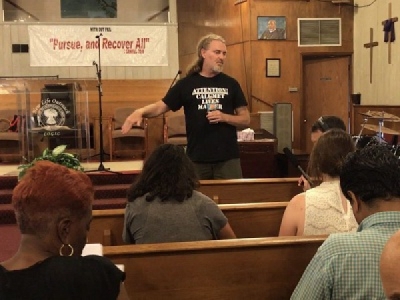
Posted on September 25, 2017
By Lauren Cross and Sarah Reese, nwi.com
State and federal environmental officials said Thursday they are studying an option for off-site disposal and capping of contaminated sediment “hot spots” in the Indiana Harbor Ship Canal.
The decision comes after months of pressure from community groups and East Chicago residents, who argued granting the permit would create unnecessary health risks and fail as a long-term cleanup solution in a city already overburdened by a legacy of toxic industrial contamination.
The Rev. Cheryl Rivera, a leader in the Community Strategy Group that led opposition to the CDF permit, said Thursday night she and other members are cautiously optimistic about the announcement.
“We want to claim a win but we also want it to be known we’re not going away,” Rivera said.
‘A permanent solution’
Thomas Frank, environmental activist and CSG member, said the group still has several questions about the scope of the feasibility study, which he says is lacking in detail, and what happens at the conclusion of that study.
At least, for now, the group’s strong opposition has delayed any decision on the permit, he said. The news release from IDEM did not indicate whether IDEM or EPA have made a final decision on the Army’s permit application.
“Ideally, we want a permanent solution,” Frank said, noting the group will continue to fight for cleaner alternatives, such as detoxifying the sediment.
The Army Corps of Engineers sought approval in 2014 to dispose of sediment containing polychlorinated biphenyles, or PCBs, at concentrations of more than 50 parts per million in a confined disposal facility.
The Army Corps in 2012 began storing sediments with PCBs concentrations below that threshold at the facility at 3500 Indianapolis Blvd. The property is owned by the East Chicago Waterway Management District and operated and maintained by the Army Corps.
The confined disposal facility is just blocks from East Chicago Central High School and the new Carrie Gosch Elementary School, where students living in the lead- and arsenic-contaminated USS Lead Superfund site were transferred last year after the School Board voted to close their neighborhood school. Whiting and the Robertsdale neighborhood in Hammond are also less than a half mile from the facility.
The Indiana Department of Environmental Management and U.S. Environmental Protection Agency said they reached an agreement to investigate off-site disposal of sediment after hearing residents’ concerns during community meetings in March and June and meeting with community leaders in August.
Community groups opposed storage of the mostly highly contaminated sediment in the confined disposal facility as proposed, but they were not against dredging.
Great Lakes Legacy Act
The Great Lakes Area of Concern remedial action plan, first drafted in 1991, called for dredging of the harbor and ship canal in part because of the potential threat contaminated sediments posed to the drinking water supply of East Chicago, Whiting and Hammond.
EPA lists the harbor and canal as the most contaminated in the Great Lakes area because they’re saturated with 362 toxic and cancer-causing substances.
Environmentalists of years past lost their fight against the confined disposal facility. The Army Corps has dredged every year since 2012 and concluded its last season in fall 2016, said Natalie Mills, project manager.
The Army Corps’ contractor is scheduled to resume dredging next week, with plans to remove 200,000 cubic yards of sediment and hydraulically offload it into the confined disposal facility, Mills said.
“We have coordinated closely with USEPA and IDEM on many aspects of the Grand Calumet River Area of Concern projects including navigation dredging,” Mills said. “USACE has provided and will continue to provide technical expertise.”
IDEM said the agencies are exploring using the Great Lakes Legacy Act to fund off-site disposal.
The Army Corps and U.S. Fish and Wildlife Service helped make the option viable, and ArcelorMittal Indiana Harbor agreed to provide access to the canal via its property and space to properly and safely treat the dredged materials before shipment, according to the release.
Pruitt: EPA is committed
If the off-site disposal option is determined to be feasible, the agencies anticipate finishing remedial design by spring 2018 and completing all dredging activities by late 2018.
“EPA is committed to addressing contamination in the Indiana Harbor Canal and protecting the health and safety of East Chicago residents,” EPA Administrator Scott Pruitt said in the release. “After visiting East Chicago earlier this year, ensuring close coordination with the state of Indiana has been one of my top priorities. Together, we are exploring new ways to address concerns raised by the community.”
IDEM Commissioner Bruno Pigott said in the release that his agency hears the community’s concerns.
“We are very thankful to our partners who came together to make this option available to the residents of East Chicago,” he said.
If the toxic material isn’t stored in East Chicago, Frank warned it may end up in another Northwest Indiana community— one equally overburdened by industrial waste already.
“We don’t want to put that burden on them … If they were to go to another community, we would follow them and try to organize that community to stop it,” Frank said.
Source: nwi.com





